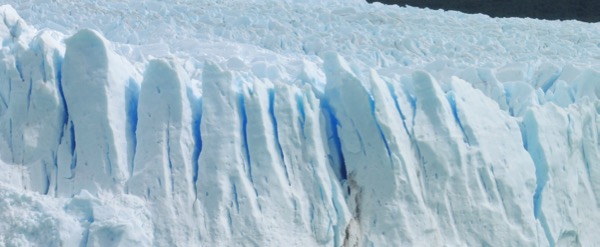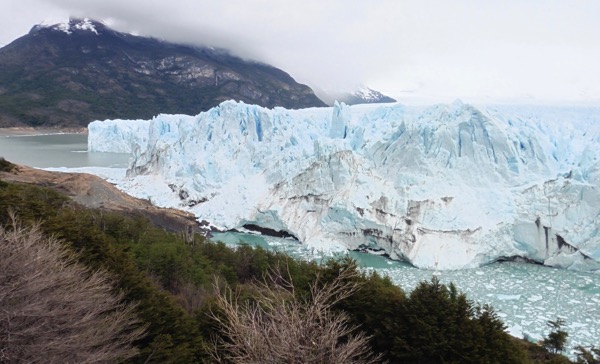After a day of exploring the spectacular peaks of Torres del Paine National Park in Chile, we wondered how a second day in the park could hold a candle to that. The answer came by way of a very different sort of adventure.
The big activity for the day was scheduled for the afternoon, so in the morning we took a leisurely hike around the grounds of our hotel. This was a cooler and cloudier day. The spectacular views of the peaks we’d had yesterday were now reduced to this:
A pair of gauchos passed us:
Not much later a lady tourist with a guide from the hotel stopped to chat:
If the lady strikes you as photogenic, that may be because she is a TV personality from Spain doing a travel piece about Patagonia.
There were birds of many varieties to see along our way. I like to say that in the Southern Hemisphere robins are orange on top and black beneath:
I believe this bird is called an Oyster Catcher:
And a pair of male geese contesting the pecking order:
This view was the goal of our little hike:
Here’s a view of our hotel I snapped as we returned:
A short while later, as we left on our tour bus I got this shot showing more of the extent and setting of our hotel:
Though we’d been in Torres del Paine park for more than a day, we now made our first stop at the visitors’ center:
Our next destination can be seen on the map above: the long, light blue lake leading to a glacier in the upper left corner. We would board a boat at the southern end of the lake, cruise up to the glacier, and then return. Also, note that the end of the glacier is split by two outcroppings of rock, one large and one small. Those will be apparent in the photos below.
Our bus took us as close to the lake as it could, but we had to hike the rest of the way. Along the trail we passed a small owl:
We had to cross a suspension bridge with a posted capacity of no more than six people at a time:
It was a cold and blustery day, giving me a perfect excuse to try out my new stocking cap that I’d bought on Chiloe Island:
Here’s a view from the other end of the bridge as the rest of our party cross:
We thought we were getting close to the lake when we reached sand, but the beach was nearly a mile wide:
In the photo above, you can see icebergs that have calved off the glacier. Here’s a panoramic shot of the lake:
At the far end of the lake, below the snow-capped peak, you can just make out the glacier itself. Here’s a close up of one the icebergs:
Smaller pieces of ice float right up to the shore:
Adjacent to the beach was a natural arch:
We had a rather long wait for the boat, which gave me time to do some birdwatching:
My cousin Tom took a trail up a nearby cliff:
Finally, our boat arrived. We were ferried from shore in a smaller motorboat. This is a shot from the tour boat back to the rest of our group waiting to be ferried:
Heading toward the glacier, we passed many more icebergs:
We also got new perspectives on the peaks we’d seen the day before:
Each of us that wanted to got a turn at the wheel:
After about an hour on the boat, we were getting close to the glacier itself:
Remember from the map above that outcrops of rock split the glacier into three fingers. We approached the finger on the right first:
We then cruised around the larger outcrop of rock, which had very pronounced striations:
In the photo below you see the second and third fingers of the glacier:
This photo is a panorama of the large third finger:
I’m always fascinated by the endless variety of shapes, and particularly by ice caves:
The boat crew was fearless about pushing in among the chunks of floating ice:
They even scooped up some and served everyone onboard a Pisco Sour chilled with glacial ice:
By the time our boat returned to the south end of the lake, the wind had picked up considerably, and that mile long slog back across the beach was particularly frigid. We were all happy to spend a second cozy night back at our scenic hotel in the park.
The next morning, we boarded our bus to leave Chile, headed for the city of El Calafate in Argentina. We got one last view of Torres del Paine as we pulled away:
Though Torres del Paine and El Calafate are not that far apart as the crow flies, both nestled on the eastern slopes of the Andes, we had a day-long drive, first northeast, then northwest, to get around intervening mountains. We stopped just before the border crossing to Argentina for lunch of a very rustic stew typical of the area:
Later in the day, we stopped at a cafe in the middle of nowhere to stretch our legs. There, we got to experience the local way of serving hot chocolate: a glass of hot milk served with a chocolate bar - in the shape of a submarine - which you submerge and stir into the milk. It was delicious:
El Calafate is a small, isolated town in southwestern Argentina that has experienced a recent surge in interest as the hometown, and sometimes residence, of the then-president of the country. Our rooms there were particularly charming:
From the windows of the hotel restaurant we could watch a gaucho working his sheep:
A young colt was also a popular sight:
The next morning our bus headed west into the Andes. On the outskirts of town, we passed a lake with a large flock of flamingos:
The three flamingos on the right of the photo above are adolescents who have not yet acquired their pink color by eating enough shrimp.
Further into the countryside, we saw a hawk:
and a caracara:
Caracara’s are known to kill full grown sheep by perching on their head and pecking out their eyes.
Our destination for the day was Parque Nacional Los Glaciares:
After the glacier two days ago at Torres del Paine, this might seem like an anticlimax, but it surely wasn’t. This is a much much larger glacier. Just for example, the face of the previous glacier was 100 feet high, today’s glacier reached 200 feet high in places. We got our first view from a distance:
Though the glacier fronts on a lake, as the map above shows, land runs very close in front of it and it is from there that we would view the glacier. This panorama takes in the entirety of the glacier:
The following two shots show some of the extensive system of walkways that have been built for viewing the glacier:
Below is Sebastian, our trip leader, sporting a new hat:
I think the photograph below gives sense of the scale of the glacier, with the relatively tiny boat at the left of the image:
Here are some of the interesting forms:
A considerable amount of patience on my part was rewarded by being able to capture this series of images and a video of a significant calving event. :
I recommend you make the movie fullscreen for viewing:
One more aspect I want to draw your attention to: notice how the lake on the left is higher than the lake on the right:
During the winter months ( in the Southern Hemisphere ) the glacier advances and creates an ice dam between the two lakes. In the warmer months, the glacier recedes sufficiently for the lakes to reconnect and water rushes from one to the other. Five months after we visited, that process completed as the remaining ice bridge collapsed, making international news.
As I headed back toward the visitor center I passed this guy:
It had been a cold but rewarding afternoon. To warm up, I treated myself to a chocognac ( hot chocolate + cognac ) in the visitors’ center.
Back in El Calafate, my cousin Tom, his wife Kathy, and I decided to mark our last night in Patagonia with good meal at a restaurant down the road from our hotel. Inside the entrance to the restaurant, you see the lamb being roasted:
Tom and Kathy ordered a platter of lamb for two:
I got a similar platter, sized for one, which was still a lot to eat. The desert was equally spectacular:
The next morning we were all on a plane back to Buenos Aires. Our flights to the States left the evening of the next day. So that morning was free for our last, and rather impromptu, exploration in South America, the topic of my next post.




























































































No comments:
Post a Comment